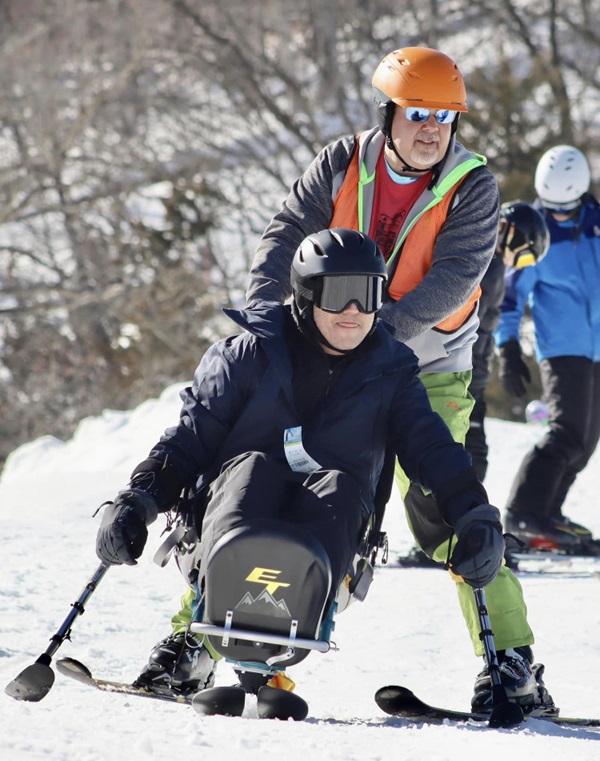Cold weather and snow are challenging for anyone who enjoys the outdoors, and they are especially hard on people with disabilities.
But for nearly 40 years, the Gateway Disabled Ski Program (GDSP) has been helping disabled people hit the slopes at Hidden Valley Resort in Eureka, Missouri.
“Seeing the smiles on their faces as they go down the hill is amazing,” says Bob Kristof, president of the GDSP board. “It gives me chills thinking about how we can change somebody’s life.”
How It Started
The GDSP began in the mid-1980s when skier Lyle Siemer saw a one-day Special Olympics skiing event going on at Hidden Valley. The idea of helping people with disabilities learn to ski captured his imagination, and he talked to Hidden Valley founder and owner Tim Boyd about making it a regular event. Boyd liked the idea, too, and proposed creating a weekly program.
By the late 1980s, Siemer and Boyd had formalized the program into the GDSP, a nonprofit organization. The Missouri School for the Blind also joined in. In 2013, the GDSP merged with the Disabled Athlete Sports Association in St. Charles, but by 2019, it had regained its independent status.
Today, the GDSP’s mission is to develop lifetime skills for people of all ages and abilities by providing an affordable ski experience. Skiers develop self-esteem, confidence, physical skills, and social connections while having fun. This leads to increased participation in other areas of their lives, ultimately enriching the community.
How It Works
On Monday and Thursday evenings during the season, about 50 athletes and volunteers ski for free, thanks to a grant from Colorado’s Vail Foundation. The Missouri School for the Blind adds another 70 skiers. Mondays also feature a clinic for veterans with disabilities, and weekend clinics reach another 50 to 75 people.
“One of our veterans was down on his luck and considering suicide when he first started skiing,” Kristof says. “Now he helps to run the veterans’ clinic and says that skiing is one of the reasons he’s still around today.”
Safety is the top priority, says Kristof. Skiers usually start on the ground before being carried by the Magic Carpet conveyor system up the bunny hill. As skiers’ skills and comfort levels rise, they can work up to more challenging slopes, protected by volunteers, ropes, tethers, and other safety tools.

Both participants and volunteers gain enjoyment from the Gateway Disabled Ski Program. (GDSP)
The program’s variety of equipment also helps ensure comfort and safety. Thanks to grants and donations, the GDSP has acquired a significant amount of equipment — even more than many Western ski resorts.
For example, sit-down skis allow those who don’t have use of their legs to steer by shifting their torsos to the left or right. Walker-like stand-up pop riggers and bicycle-like frames allow skiers with more leg mobility to ski from a standing position. People with conditions like cerebral palsy can ski with hula-hoop-like devices, and visually impaired skiers follow volunteers who employ clickers or bells. Kristof even recalled using computer printing to modify equipment for a skier with legs of different lengths.
“Our goal is to make skiing available to everyone,” he says.
Changing Lives
One regular at Hidden Valley is Bobby Reidelberger. A middle school teacher by day, on Monday and Thursday evenings he transforms into a skier, despite being unable to use his legs.
“Growing up in a small Illinois town, I’d never heard of a person with disabilities being able to snow ski,” Reidelberger says. “I had been water skiing with the Missouri Water Skiing program, and Bob was there one day helping out. He asked if I had tried snow skiing before, and I started learning. I was in my late 30s. I wish I’d known about it 20 years earlier!”
Now 43, Reidelberger teaches young skiers himself, in addition to the middle schoolers he works with every day.
“I tell kids all the time that I don’t have a disability. I just have a different condition,” Reidelberger says. “The only person who can make something a disability is yourself. If you tell yourself that you’re not capable of something, even if you’re a perfectly able-bodied person, you won’t be able to do it.
“Like I always say,” Reidelberger adds, “the best way to get someone with a disability to do something is to tell them they can’t.”
For more information on the GDSP, visit gdspstl.org.
Author: Tim Fox is a contributor to Terrain.
Top image: Courtesy of the Gateway Disabled Ski Program.


Leave A Comment